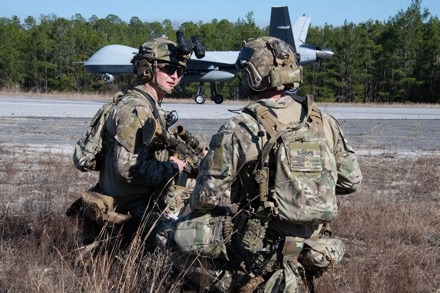DUKE FIELD, Fla. —
The 919th Special Operations Wing made history Feb. 3, 2024 demonstrating a new capability on the same airfield some of the Air Force’s most revered aviation pioneers trained more than a half century ago.

Throughout the four-day exercise, the unit integrated non-standard aviation, Remotely Piloted Aircraft and Mission Sustainment Team operations to prepare for future contingencies where the famed Doolittle Raiders trained for their daring one-way mission in the offensive against Japan decades ago.
“This exercise demonstrated the 919th’s ability to employ the functionality of an entire unit and establish an operational air base all while maintaining a very small footprint,” said Col. Jason Grandy, 919th SOW commander. “We developed this training to fit AFSOC’s deployment model which is focused on the competition between rising powers. We did it in a manner that also allowed us to validate a proof of concept for a few of our mission sets.”
As part of the exercise, members from the 919th Special Operations Security Forces Squadron and 919th Special Operations Medical Squadron flew aboard a C-146A Wolfhound aircraft to perform a medical evacuation for critically injured servicemembers at a remote overseas location. After the aircraft landed, members applied life-saving medical care on a simulated battlefield before loading the casualties on stretchers for transport on the C-146 back to a higher level medical facility for treatment and care.
“Our security forces members are elite and have some of the best training to protect not only the lives of aircrew but also those on the battlefield,” said Grandy.

Air Commandos from the 2nd Special Operations Squadron used the venue to continue devising strategies to enhance the capabilities of the MQ-9 Reaper. In this case, they integrated the weapons system into the exercise in ways it has not been used before.
“We are transforming for the future in every aspect of our mission,” said Lt. Col. David Payne, 2nd SOS commander. “Not only did our members accomplish the shortest known runway landing for an MQ-9 via Satellite Launch and Recovery to date, we also provided casualty evacuation overwatch, as well as ammo resupply to ground forces.”
The culture of innovation that lives within the squadron was the catalyst behind an initiative to provide an ammo resupply using an MQ-9 travel pod after completing a short field landing on Eglin Aux Field 1 (Wagner Field).
“I think it’s important to point out that in February 1942, Doolittle and his crew trained for the shortest takeoff in B-25 history (400 feet),” said Payne. “Now 82 years later, we are following in his footsteps landing the MQ-9 on the shortest known field on the same airfield. The achievement required technical order waivers which allowed for a 33 percent decrease in runway required for landing.”
Payne noted the aircraft departed the tarmac at Hurlburt Field, Fla., near a facility named The Richard E. Cole building. Cole was the co-pilot for Doolittle on the lead aircraft for the Doolittle Raiders and the last surviving member of the Raiders before passing away in April 2019 at the age of 103.
The 919th Special Operations Mission Support Group was equally impressive proving they can provide the warfighter with operational flexibility for mission sustainment and generation with a very small footprint.
Mission Sustainment Teams are comprised of highly trained personnel to set up a contingency location for a brief period of time. These specialized teams include a variety of support specialists to offer a base operations capability with skill sets in fuels, communications, security forces and civil engineering among others.
“We provided MST elements at multiple forward locations throughout the exercise enabling airlift and overwatch assets to transit and receive the support needed while they were on the ground,” said Col. Olivia Nelson, 919th SOMSG commander. “This is the first time our Airmen have exercise the deployment of multiple elements of an MST, and we learned many valuable lessons in the process. I’m incredibly proud of their efforts.”
Payne commended the support specialists for enabling his unit’s exercise objectives and concluded by promising to continue pushing the envelope for innovative and transformation.
“We’re not done,” said Payne. “We’ll keep leaning forward and doing things only SOF [Special Operations Forces] can do.”
By LtCol James R. Wilson, 919th Special Operations Wing

